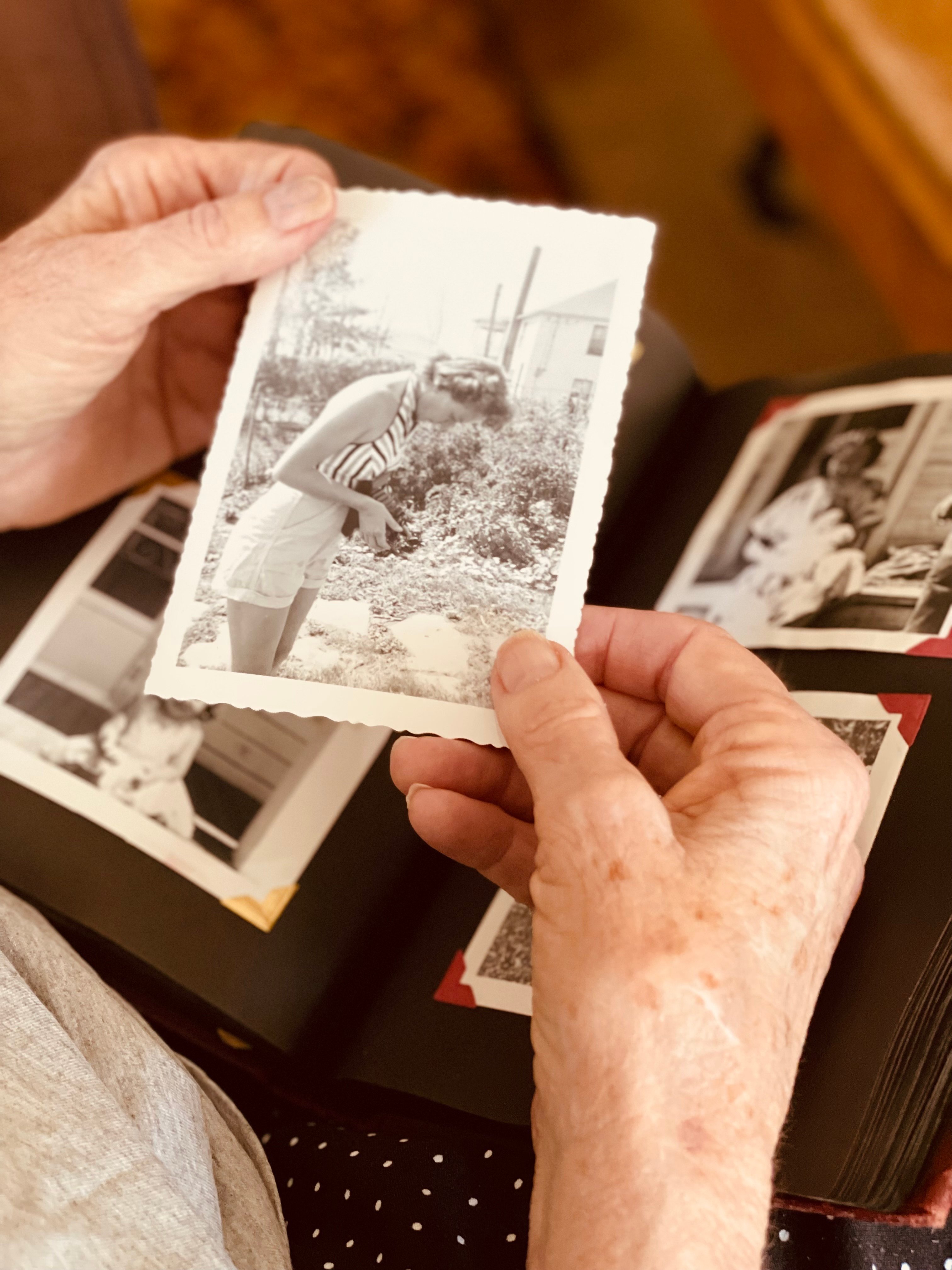It’s more than your family tree: Making Family History Month meaningful for seniors
by Katie Wright | Oct 13, 2021 | family support, activities for seniors, resources on aging | 0 Comments

Family History Month has been a national October celebration for the last 20 years. It’s a great time to connect with your family’s story through activities everyone- especially older adults- will enjoy.
If you Google Family History Month you’ll find plenty of opportunities to dig into your genealogy — the research of your family tree. It’s a popular pastime that helps you discover where many generations of your relatives came from. There are several online programs and access to archival information to get you started. If you’re captivated by your ethnic ancestry, genealogy can be a fascinating pursuit.
But it’s not the only way to make Family History Month meaningful.
Leave exploring your genetic background for another time and instead turn to family stories. There are intriguing ways to have fun learning about your family’s culture and social surroundings – how your grandparents lived and worked and celebrated their lives.
Family History Month can be about relishing things meaningful to family members both living and dead. It can be about reminiscences, secrets, and treasures. It’s imagining families as intricate tapestries, each piece woven carefully into the fabric of the whole.
Of course, there’s no reason to limit the discovery of family history to one month, and now is a great time to get started with holidays just around the corner. There are a lot of pieces to explore – food and recipes, photographs, and traditions.
The ties that bind these pieces together are the stories around them. Every family recipe, photo, and tradition has a story that needs to be told and shared with younger generations.
Celebrate the family meal
Sunday dinner was a thing in my childhood home. My parents made it an afternoon event, and any family member close enough to come was invited. It’s no surprise to me now, thinking about it 50 years after the fact, that these Sunday dinners were always popular. Each dinner was a celebration of sorts, whether it was a holiday meal or just a chance to relish good food.
Food brings people together. Homemade food has the power to connect us – like family favorites or special recipes. Family creations have the ingredients we crave: warmth, good smells, familiarity, and a little history. Recipe sharing gives us a way to honor family traditions while adding our own twist with a different flavor or ingredient.
For Family History Month, explore what’s behind a favorite recipe. There’s always at least one or two in every family. It’s often a dessert – something everyone loves because it’s a special treat. There’s a story connected to it because it sparks memories and continues to get passed along.
You might enjoy gathering well-loved recipes together into a family cookbook. Each person can declare a favorite and the end product will be a treasured legacy. This activity could include doing research into the roots of the recipe, how the choice of ingredients has changed over time, and what kind of occasions call for it to be served.
According to the Family Dinner Project, research shows family dinner improves literacy, boosts vocabulary, and improves storytelling skills. If your family has an opportunity for multi-generational meals, think of the stories you can share during your time together. And consider the benefits for everyone – especially seniors and youngsters.
Connect to each other with photos
Are you fortunate enough to have older family photos organized into albums? Then you already know how much fun it is to browse through them with your loved ones. It’s an activity everyone enjoys, and one that’s likely to get older adults involved with memories and stories.
Even if an older photograph doesn’t include faces familiar to the younger members of your family, it can still spark conversation. Every single picture has a story behind it. Where was it taken? Who are those people and how are they related to you? What year was it? Who took the picture?
If you haven’t had a chance to wade through your boxes of photos, enlist a few family members to help. If you’re the elder in the group, you’ll have the best perspective on names and dates. Others can help you determine which are worth saving. Someone can serve as the official scribe to note details of the story behind selected pictures. If there are duplicates, some may find a new home with family members who want their own copy.
Create a collage of old photos and make it a gift for parents or grandparents.
If there’s an older member of the family in a long-term care or assisted living facility, choose beloved photos for them that can trigger fond memories. This is a gift of comfort and familiarity.
Printed photos are fast becoming less common but there are multitudes of digital photographs created every day. Everyone’s a photographer thanks to sophisticated phone and digital cameras. They make results instantly available and ready to be shared and enjoyed on the spot.
For widespread sharing, it’s relatively easy to assemble your own digital photo album or create a digital video or photo slideshow. Enlist the help of a tech-savvy friend or family member if you need assistance.
Keep traditions to strengthen generational bonds
Family traditions come in all colors of the rainbow. They’re often the key element in celebrations, something to look forward to and rely on. They’re also the perfect opportunity for including older adult family members or friends.
Most of us think of holiday events as traditions, but there are other activities that also hold special meaning. When my kids were school-aged, each year we joined another family on the last day of school for milkshakes at a favorite diner. We celebrated the year and talked about plans for the summer. I’m betting that little tradition will spark a similar “school’s out” routine for my grandkids when they’re a little older.
Other non-holiday traditions are activities like regular game nights, when board games take center stage. Movie nights can include popcorn in the dark and enjoying old classics along with new releases.
Bedtime reading is another. Here’s a wonderful account of a dad who read to his daughter every night for nearly nine years. Traditions like these are great ways for older adults to be an active part of their families’ lives.
Everyone benefits because traditions are inclusive.
Holiday traditions give family members a chance to understand what’s meaningful. They provide a definition of who we are and a link from one generation to the next. These traditions offer hope and warmth, particularly to the older members of our family. They might include music and special decorations – things that stand the test of time and can be passed along to others.
There’s always a story of how holiday traditions came to be, whether they’re born of religious significance or family preference. New traditions combined with old can bring fresh meaning to celebrations.
Use family stories to impart valuable lessons
If you’re a senior adult whose older relatives are gone, you may find yourself in the role of family elder and the holder of stories younger family members should hear.
Such stories are actually very beneficial for both old and young. Older adult storytellers can enjoy imparting family history that’s meaningful to them and brings memories into sharp focus. Younger family members have a chance to understand more about their identity and that they’re a part of a larger story. Young people are surprisingly good at being able to retell the stories that are most memorable.
Stories that include people’s emotions and reactions bring them to life. I learned about my father’s sense of humor and ability to be a good sport when hearing the story about his impromptu modeling career. My mother worked as a fashion illustrator for a large department store, and she’d bring home women’s clothes to drape on dad’s frame in order to create realistic-looking illustrations. The thought of my dad posing for her in fashionable women’s clothes was hilarious to all of us.
Family stories bring each of us into clearer focus as real human beings. They can be inspirational or cautionary tales. Hearing stories of an older family member’s missed opportunity can help us realize that these experiences are part of life. They may teach us something about resilience.
For Family History Month, think about stories that need to be shared. Do a little preparation and pick a time to get the storytelling ball rolling:
- Remember your audience – if there are children, pick stories they can relate to.
- Do some advance planning to make sure you hit the high points of your account.
- Think of ways to introduce your story or ways to make it more relevant to your audience.
Above all, have fun with it – keep your stories as entertaining as possible. You might even want to make family storytelling a regular event.
At SeaCare we encourage Family History Month activities because families are the heart of our business. Those we support with in-home care feel like part of our own family. Contact us to learn more.
Katie Wright writes about aging and senior wellness from Bellingham, WA. You can read more about her here.
If you or a loved one you know are looking for additional support during this time and are interested in scheduling a free in-home assessment, please contact SeaCare In-Home Care Services today! A SeaCare family member is standing by. 425-559-4339.



0 Comments